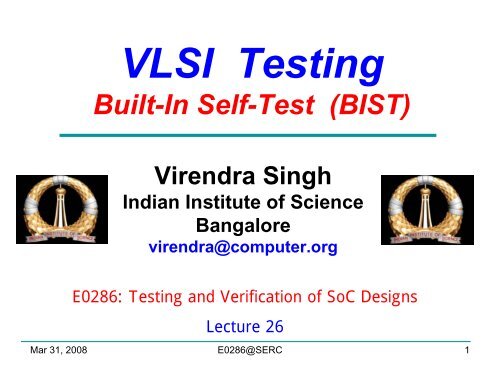Create successful ePaper yourself
Turn your PDF publications into a flip-book with our unique Google optimized e-Paper software.
Logic BIST• Complex systems with multiple chips demandelaborate logic BIST architectures‣ BILBO and test / clock system‣Shorter test length, more BIST hardware‣ STUMPS & test / scan systems‣Longer test length, less BIST hardware• Benefits: cheaper system test, Cost: more h/w• Must modify fully synthesized circuit for BIST toboost fault coverage• <strong>In</strong>itialization, loop-back, test point hardwareMar 31, 2008 E0286@<strong>SERC</strong> 2
<strong>Test</strong> / Clock System Example• New fault set tested every clock period• Shortest possible pattern length• 10 million BIST vectors, 200 MHz test / clock• <strong>Test</strong> Time = 10,000,000 / 200 x 10 6 = 0.05 s• Shorter fault simulation time than test / scanMar 31, 2008 E0286@<strong>SERC</strong> 3
BILBO – Works as PG and RC <strong>Built</strong>-in Logic Block Observer (BILBO) -- 4 modes:1. Flip-flop2. LFSR pattern generator3. LFSR response compacter4. Scan chain for flip-flopsMar 31, 2008 E0286@<strong>SERC</strong> 4
Complex BIST Architecture• <strong><strong>Test</strong>ing</strong> epoch I:‣ LFSR1 generates tests for CUT1 and CUT2‣ BILBO2 (LFSR3) compacts CUT1 (CUT2)• <strong><strong>Test</strong>ing</strong> epoch II:‣ BILBO2 generates test patterns for CUT3‣ LFSR3 compacts CUT3 responseMar 31, 2008 E0286@<strong>SERC</strong> 5
Bus-Based BIST Architecture‣ <strong>Self</strong>-test control broadcasts patterns to each CUT overbus – parallel pattern generation‣ Awaits bus transactions showing CUT’s responses tothe patterns: serialized compactionMar 31, 2008 E0286@<strong>SERC</strong> 6
<strong>Built</strong>-in Logic Block Observer(BILBO)• Combined functionality of D flip-flop, patterngenerator, response compacter, & scan chain• Reset all FFs to 0 by scanning in zerosMar 31, 2008 E0286@<strong>SERC</strong> 7
Example BILBO Usage‣ SI – Scan <strong>In</strong>‣ SO – Scan Out‣ Characteristic polynomial: 1 + x + … + x n‣ CUTs A and C: BILBO1 is MISR, BILBO2 is LFSR‣ CUT B: BILBO1 is LFSR, BILBO2 is MISRMar 31, 2008 E0286@<strong>SERC</strong> 8
BILBO Serial Scan Mode B1 B2 = “00” Dark lines show enabled data pathsMar 31, 2008 E0286@<strong>SERC</strong> 9
• B1 B2 = “01”BILBO LFSR PatternGenerator ModeMar 31, 2008 E0286@<strong>SERC</strong> 10
BILBO in D FF (Normal) Mode• B1 B2 = “10”Mar 31, 2008 E0286@<strong>SERC</strong> 11
BILBO in MISR Mode• B1 B2 = “11”Mar 31, 2008 E0286@<strong>SERC</strong> 12
<strong>Test</strong> / Scan System‣ New fault tested during 1 clock vector with acomplete scan chain shift‣ Significantly more time required per test than test /clock‣ Advantage: Judicious combination of scan chainsand MISR reduces MISR bit width‣ Disadvantage: Much longer test pattern set length,causes fault simulation problems• <strong>In</strong>put patterns – time shifted & repeated‣ Become correlated – reduces fault detectioneffectiveness‣ Use XOR network to phase shift & decorrelateMar 31, 2008 E0286@<strong>SERC</strong> 13
STUMPS Example‣ SR1 … SRn – 25 full-scan chains, each 200 bits‣ 500 chip outputs, need 25 bit MISR (not 5000 bits)Mar 31, 2008 E0286@<strong>SERC</strong> 14
STUMPS <strong>Test</strong> procedure:1. Scan in patterns from LFSR into all scan chains(200 clocks)2. Switch to normal functional mode and clock 1 xwith system clock3. Scan out chains into MISR (200 clocks) wheretest results are compacted‣ Overlap Steps 1 & 3 Requirements:‣ Every system input is driven by a scan chain‣ Every system output is caught in a scan chain ordrives another chip being sampledMar 31, 2008 E0286@<strong>SERC</strong> 15
Summary LFSR pattern generator and MISR responsecompacter – preferred BIST methods BIST has overheads: test controller, extra circuitdelay, <strong>In</strong>put MUX, pattern generator, responsecompacter, DFT to initialize circuit & test the testhardware BIST benefits:‣ At-speed testing for delay & stuck-at faults‣ Drastic ATE cost reduction‣ Field test capability‣ Faster diagnosis during system test‣ Less effort to design testing process‣ Shorter test application timesMar 31, 2008 E0286@<strong>SERC</strong> 16
Thank YouMar 31, 2008 E0286@<strong>SERC</strong> 17
















